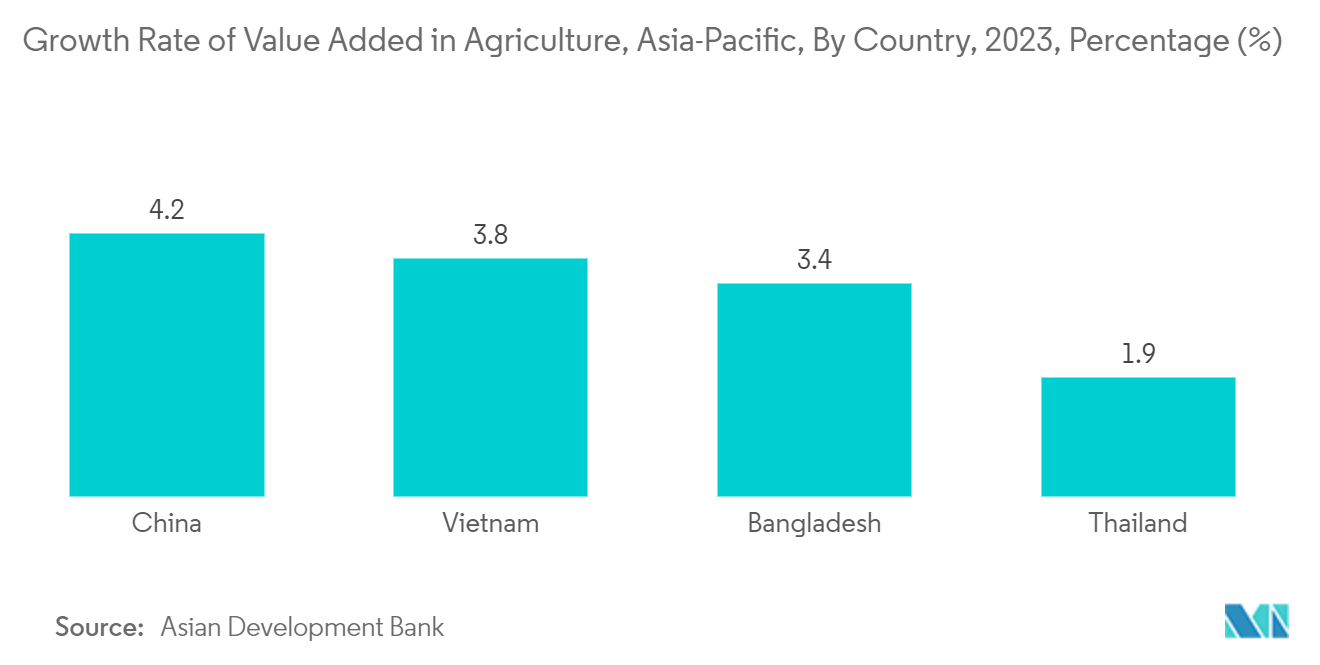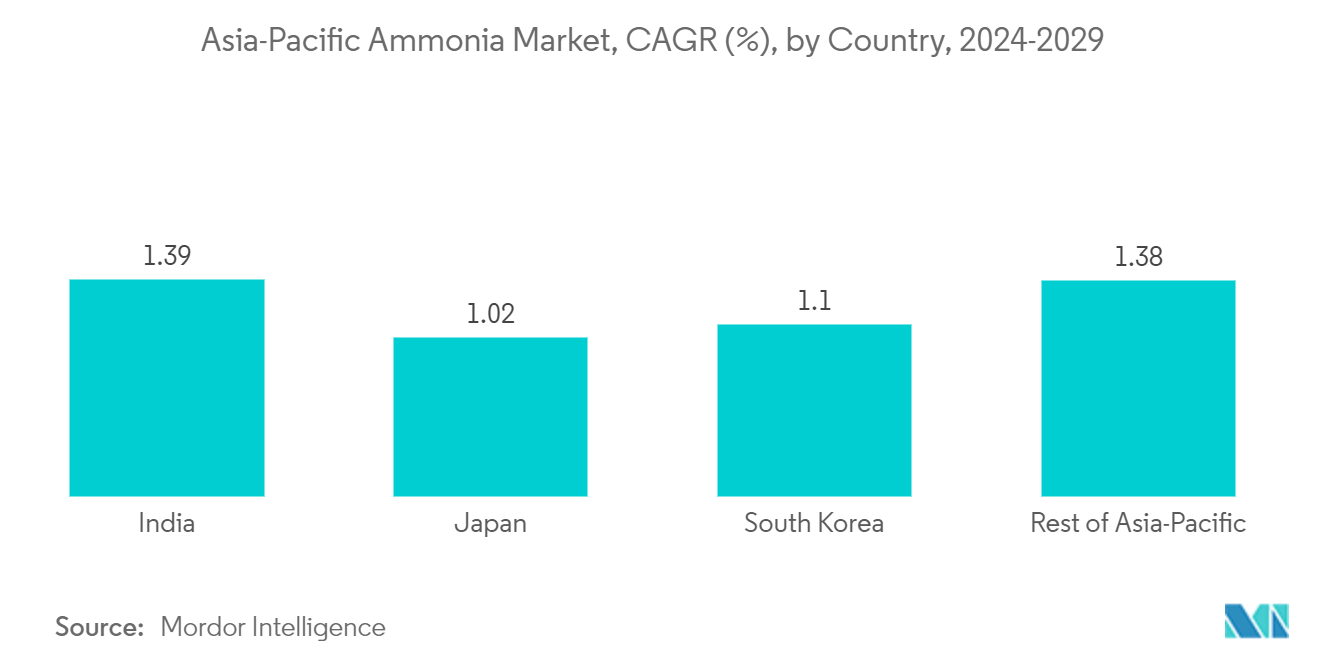Market Trends of Asia-Pacific Ammonia Industry
Expanding Agricultural Industry Driving Market Growth
- Ammonia (NH3) is recognized as one of the most efficient and widely used nitrogen sources for plant growth, with its relatively easy application and ready availability boosting its use as a fertilizer.
- Ammonia, when used as a fertilizer, offers notable environmental advantages. Directly supplying plants with nitrogen curtails the necessity for overusing other nitrogen-based fertilizers, which often lead to nutrient pollution in water bodies.
- Ammonia is an indispensable component in the fertilizer industry, especially in Asia-Pacific. The region is experiencing a population boom, leading to an increased demand for food. Therefore, to meet the augmenting food demand, farmers are expected to maximize crop yields from limited arable land.
- As a result, ammonia plays a pivotal role in supporting Asia's agricultural industry and ensuring food security.
- On September 27, 2022, the Asian Development Bank announced plans to provide approximately USD 14 billion over 2022–2025 to ease the worsening food crisis in Asia and the Pacific.
- The primary livelihood for more than 55% of India's population is still agriculture, which highlights the nation's heavy dependence on this industry.
- India is the fourth-largest agrochemical producer worldwide and is recognized as an ideal base for export-oriented agrochemical production, as per the Federation of Indian Chambers of Commerce and Industry’s (FICCI) report on the fertilizer industry.
- As per the Department of Fertilizers, in FY 2023, about 21.9 million metric tons of fertilizers were produced in India, rising from 20,700 kilotonnes (1,000 tonnes) in the previous year. However, the consumption of fertilizers amounted to approximately 30,600 kilotons in FY 2023, which was additionally met by imports.
- Malaysia's fertilizer industry is heavily influenced by the robust agriculture and plantation industries, which are its primary consumers. Mineral fertilizers dominate Malaysia's farming, representing over 90% of all fertilizer usage. In line with a rapid increase in crop production, particularly in plantation crops like rubber, oil palm, and cocoa, fertilizer consumption has risen accordingly.
- In 2023, Malaysia produced approximately 5.91 million metric tons of fertilizer, marking a slight decrease from the previous year. However, this production was the second-highest on record, underscoring the significance of ammonia.
- While agriculture contributes only 20% to Vietnam's GDP, over 70% of the country’s population depends on it. Nitrogen is often deficient in Vietnamese soils, so nitrogen-based fertilizers are the most widely used.
- In 2022, Vietnam's urea fertilizer exports saw a significant uptick, with a 348,000-ton increase from the previous year, totaling 757,000 tons and representing 30% of the nation's total production.
- Therefore, the growing utilization of fertilizers in different ways in the Asia-Pacific agricultural industry is expected to boost the demand for ammonia during the forecast period.

China Expected to Dominate the Asia-Pacific Market
- China is the largest producer and consumer of ammonia worldwide. According to the US Geological Survey (USGS), the country produced 43 million metric tons of ammonia in 2023.
- The demand for ammonia in the country is rising due to increasing applications in agriculture, along with the fertilizers, textiles, pharmaceuticals, and mining end-user industry segments.
- China accounts for approximately 7% of the overall agricultural acreage globally, thus feeding 22% of the world’s population. The country is the largest producer of various crops, including rice, cotton, and potatoes. Hence, the demand for ammonia, which is used as a fertilizer, is rapidly increasing owing to the country's large-scale agricultural activities.
- China has the most significant agricultural output among all other countries. In China, about 10% of its land is suitable for cultivation. The limited space for cultivation has led to severe food shortages in the past. China is planning to modernize and upgrade agriculture in the next ten years. The focus of China’s agricultural development is expected to shift from increasing production to improving quality.
- China leads globally in terms of nitrogen (N) fertilizer consumption. Although using nitrogen fertilizers has contributed significantly to food production in China, the country continues to focus on securing fertilizer supplies and stabilizing prices.
- In the textile industry, liquid ammonia produces synthetic fabrics. Liquid ammonia has been found to have wide applications in the tanning industry and in the production of dyes used in textile coloring.
- In the textile end-user industry segment, the country has witnessed significant growth over the decade. According to the National Bureau of Statistics of China, the textile production volume in the country amounted to 33 billion meters in 2023, compared to 38.2 billion meters during the previous year. In 2021, 23.5 billion meters of textiles were produced.
- Moreover, the Chinese government announced plans to make Xinjiang the hotbed for textile and apparel manufacturing and has invested USD 8 billion in recent years. By 2030, the northwest region of China is expected to become the country’s most extensive textile production base.
- The pharmaceutical industry in China is also one of the largest worldwide. The country produces generics, therapeutic medicines, active pharmaceutical ingredients, and traditional Chinese medicine. More than 90% of the drugs registered in the country are generic. The pharmaceutical industry in China is expected to reach CNY 3 trillion (USD 0.41 trillion) in the coming years.
- As per the data published by China Household Electrical Appliances Association, from January to November 2023, shipments of refrigerators amounted to 79.796 million units, up by 14.3% YoY, with 40.036 million units shipped to overseas markets, recording an increase of 25.1% YoY, and 39.76 million units to the domestic market, recording an increase of 5.1% YoY. There was a V-shaped recovery in 2023 compared to the year 2022, when shipments of refrigerators stood at 75.58 million units, with a plunge of nearly 13% after two years of fast growth driven by the stay-at-home lifestyle during the COVID-19 pandemic.
- Moreover, commercial refrigerators are gaining high demand as the cold chain, food and beverage, and pharmaceutical industries are regaining momentum in the country. Production is expected to increase by around 1% for the next five years, generating revenues of over USD 85 billion.
- Thus, the abovementioned factors are expected to impact demand in the Chinese ammonia market during the forecast period.


